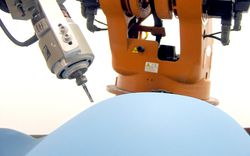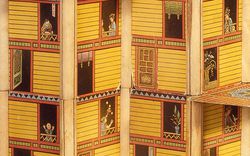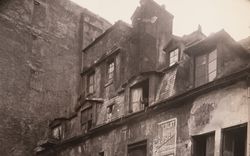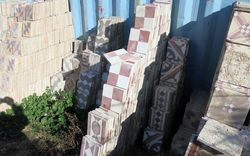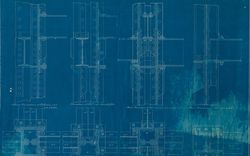Detritus, Waste, Salvage
Excerpts from a round-table discussion with André Guillerme
Although the practice of recycling construction materials had long been common in Paris, in the last third of the eighteenth century, it became increasingly systematic with the advent of the rag-and-bone man, and the growth of artisanal, industrial, and state demand. Recycled materials have tried-and-tested properties, such as endurance and strength, which makes them suitable for construction. They bear within them a value, perhaps even a spirit that can be passed on to new structures; recycled materials are often used for repairs.
A living matter
Under the effects of wind, rain, and vermin, the rendering on masonry walls swells and cracks, concrete made with slaked lime falls apart, and bad luck takes the blame. Femurs and ribs—a living matter just like pebbles—obtained from the slaughterhouse, mixed with earth, and covered with a coat of old plaster or a mix of ash and old lime, are used to plug holes that will reappear, only larger, within a few years. Timber frames, rotted away from the constant dampness of ground floors, are repaired using small pieces cut to size, and filled in with mastic.
Read more
Bleeding stones
By far, experts prefer using stones that have withstood the ravages of time, rather than the more fragile “bleeding” stones fresh out of the quarry or the mine.
Demolition
Before hovels are pulled down, they are stripped of anything valuable. Roofers collect any complete tiles they intend to reuse, and tile fragments they will resell at a high price to master masons, who will in turn transform them into cement, the hydraulic binder of slaked lime essential to the integrity of buildings in humid environments. Carpenters pull apart the wood, and take advantage of the planks, purlins, rafters and main beams they can reclaim for new buildings; the owner of the demolition often wishes to reuse this still-valuable timber for himself. Joiners scavenge the remaining door and window frames; locksmiths pick up nails and hinges, while rag-and-bone men collect anything left behind—hardware, floor tiles, bricks, and glass. Even if a hovel tumbles down, it is still a source of value for its owner.
Rubble and flower
The plaster from small demolitions—division walls, partitions—belongs to the journeyman. In order to obviate the high cost of quality gypsum, the flower of plaster, “one must look out for the knavery of plasterers who grind up old plasters” by scattering rubble in the street so that carriages might run over it, or by having their assistants crush it in the back yard, before “mixing it with new plaster.”1
-
Joseph-François Soleirol, Cahier classique de construction à l’usage des élèves d’Artillerie et du Génie de Metz (Metz: Chez Antoine Imprimeur du roi, 1819), 23. ↩
Sinews of war
A ruined building contains some one hundred cubic metres of nitrous rubble, to wit a solid three-tonne of saltpetre that can be mixed up into four tonnes of gunpowder. Paris, as the supplier of one-third of all saltpetre produced in France, is in essence the largest quarry in the kingdom, and even in all of Europe. In fact, since the reign of Francis I, all stone and plaster debris have been reserved for the saltpetre works, veritable sinews of war that extract from the mineral the destructive power of gunpowder, of which France is the largest consumer on the continent.1 For this reason, saltpetre production is a state monopoly until 1819.
At that time, Paris is the world’s largest producer of saltpetre, extracting nearly 450 tonnes from demolitions every year.
-
Since Henri II (1547), cities and communities in the kingdom must provide to the king some four hundred tonnes of saltpetre altogether. ↩
A metal of eternity
The quality of the lead produced from recycled materials is quite random: the presence of fissures, crevices, and slag increases the permeability of lead. As for cinder, which consists of smelting scum, sweepings and metal filings recovered from workshop floors, it was sold in bulk or recycled by refiners who extracted from it silver, tin, and lead. A woman from La Porte, in opposing plans to set up a lead smelter behind her home on Rue Richelieu, worried that “All foundries engage in the melting of old lead. These leads are tinged with or covered in tallow, tar, bitumen, paint, mastic, or sulphuric acid, which all melt or burn as the lead is processed, releasing an odour that is not only unpleasant, but even suffocating and unsanitary.”1
Worked with an artistry—and a risk—delicately described by La Gardette, this metal is also that of eternity: it is moulded into coffins for the high secular and ecclesiastic aristocracy, recuperated and melted for war during the Révolution, and entrusted with the heart of pious corpses to be preserved in reliquaries.
-
Rapport no 157 from 19 September 1823, from the Conseil de salubrité de la Seine (Seine Council for Salubrity). Archives de la préfecture de Police, semi-usuels, année 1823. ↩
André Guillerme visited the CCA as a Mellon Senior Scholar in 2006, before the publication of his book La naissance de l’industrie à Paris : entre sueurs et vapeurs, 1780–1830(Champ Vallon, 2007).



